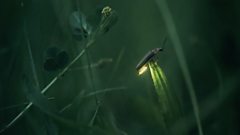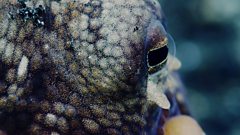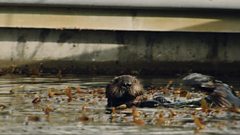
Con Artists
Chris Packham reveals that deceit is rife in the natural world – from cunning masters of disguise and sneaky thieves, to kidnapping otters and even femme fatale fireflies.
In this episode Chris Packham reveals the intelligent cons and deceitful behaviour that animal Einsteins use to survive and prosper in the game of life - from disguising themselves to outwit predators, and kidnapping babies to save their own offspring, to reading our body language to pull off a successful robbery.
We start with the ultimate master of disguise – the octopus. Prof Roger Hanlon describes how octopus intelligence rivals that of vertebrates, with extraordinarily fast and complex decision-making that transforms their appearance faster than the blink of an eye. If camouflage doesn’t fool a predator, then an octopus can change tactics to startling them instead, switching to look like something too weird to eat.
Cheetah cubs may use a disguise of sorts too. We explore a little-known theory that a baby cheetah’s appearance may fool predators into thinking they are too feisty to tackle. Young cubs bear a remarkable resemblance to honey badgers, one of the most aggressive animals in the savannah that even lions and eagles won’t mess with.
Mimicry can attract as well as repel…. the caterpillars of alcon blue butterflies smell and sound like ant larvae to cleverly con their way into a nice, safe home for the winter. Worker ants are duped into taking the caterpillar into their colony, providing it with food and shelter until the spring.
The beloved sea otter may look like butter wouldn’t melt in its mouth, but a hungry male has no qualms about kidnapping a pup whilst its mother is foraging. He only releases his hostage in exchange for a free meal.
In Australia, the super-social white-winged chough lives in large groups with only one pair breeding and the rest helping to raise their chicks. As Dr Constanza Leon explains, chough chicks are so needy that it takes seven birds to raise one chick and if times are hard, adults will use a special display to entice young birds from rival groups to join theirs and help out with childcare.
Dolphins are renowned for their intelligence, and we learn how calculating female bottlenose dolphins mate with multiple males to protect their future calves – if each male believes he could be the father then she reduces the chance of infanticide.
The ocean is the scene of another two-faced deceit. Competition for mates can be fierce, so some male cuttlefish use cunning tricks to get a female. For giant Australian cuttlefish size is important – so small males change their appearance and put on a female disguise to sneak past larger rivals and woo a mate. Marine biologist Dr Martin Garwood discovered that another species, the mourning cuttlefish, takes it one step further – a sneaky male splits its appearance down the middle to look male on one side (to attract a female) and female on the other to fool onlooking rival males. All’s fair in love and war!
Dr Sarah Lower studies the appropriately named femme fatale firefly that has learned multiple languages to lure in unsuspecting males to an untimely death. After mating with her own species, the female firefly changes her flashes to lure in males of another species – not for mating but to eat them and so ingest valuable chemicals that protect their eggs from predators.
Finally, we discover how the much-maligned gull is actually an astute opportunist, able to read our eyeline and our body language to steal a meal when the coast is clear.
Animals use every trick in the book to get ahead – being smart, sneaky and scheming can be the recipe for success.
Last on
More episodes
Previous
Next
Clips
-
![]()
Fireflies: nature's femme fatales?
Duration: 02:58
-
![]()
More than camouflage
Duration: 02:16
-
![]()
Not as innocent as they appear
Duration: 02:36
Credits
| Role | Contributor |
|---|---|
| Presenter | Chris Packham |
| Producer | Dan Slee |
| Series Producer | Joanne Stevens |
| Executive Producer | Rosemary Edwards |



